
The Ediacaran period is a geological period of the Neoproterozoic era that spans 96 million years from the end of the Cryogenian period at 635 Mya, to the beginning of the Cambrian period at 538.8 Mya. It is the last period of the Proterozoic eon as well as the last of the so-called "Precambrian supereon", before the beginning of the subsequent Cambrian period marks the start of the Phanerozoic eon where recognizable fossil evidence of life becomes common.
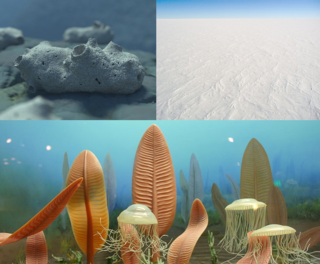
The Neoproterozoic Era is the unit of geologic time from 1 billion to 538.8 million years ago.

Dickinsonia is a genus of extinct organism, most likely an animal, that lived during the late Ediacaran period in what is now Australia, China, Russia and Ukraine. It is one of the best known members of the Ediacaran biota. The individual Dickinsonia typically resembles a bilaterally symmetrical ribbed oval. Its affinities are presently unknown; its mode of growth has been considered consistent with a stem-group bilaterian affinity, though various other affinities have been proposed. The discovery of cholesterol molecules in fossils of Dickinsonia lends support to the idea that Dickinsonia was an animal, though these results have been questioned.
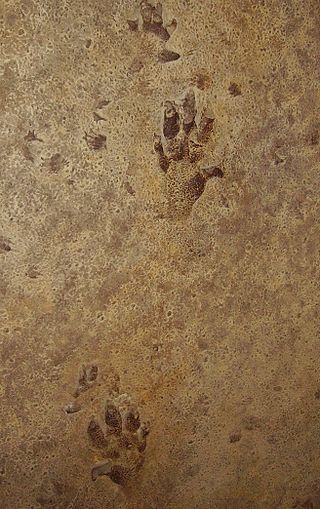
A trace fossil, also known as an ichnofossil, is a fossil record of biological activity by lifeforms but not the preserved remains of the organism itself. Trace fossils contrast with body fossils, which are the fossilized remains of parts of organisms' bodies, usually altered by later chemical activity or mineralization. The study of such trace fossils is ichnology and is the work of ichnologists.

Kimberella is an extinct genus of bilaterian known only from rocks of the Ediacaran period. The slug-like organism fed by scratching the microbial surface on which it dwelt in a manner similar to the gastropods, although its affinity with this group is contentious.

Tribrachidium heraldicum is a tri-radially symmetric fossil animal that lived in the late Ediacaran (Vendian) seas. In life, it was hemispherical in form. T. heraldicum is the best known member of the extinct group Trilobozoa.

Vendobionts or Vendozoans (Vendobionta) are a proposed very high-level, extinct clade of benthic organisms that made up of the majority of the organisms that were part of the Ediacaran biota. It is a hypothetical group and at the same time, it would be the oldest of the animals that populated the Earth about 580 million years ago, in the Ediacaran period. They became extinct shortly after the so-called Cambrian explosion, with the introduction of fauna formed by more recognizable groups and more related to modern animals. It is very likely that the whole Ediacaran biota is not a monophyletic clade and not every genus placed in its subtaxa is an animal.
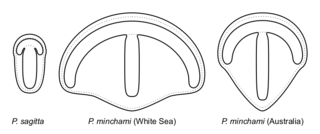
Parvancorina is a genus of shield-shaped bilaterally symmetrical fossil animal that lived in the late Ediacaran seafloor. It has some superficial similarities with the Cambrian trilobite-like arthropods.

The Ediacaranbiota is a taxonomic period classification that consists of all life forms that were present on Earth during the Ediacaran Period. These were enigmatic tubular and frond-shaped, mostly sessile, organisms. Trace fossils of these organisms have been found worldwide, and represent the earliest known complex multicellular organisms. The term "Ediacara biota" has received criticism from some scientists due to its alleged inconsistency, arbitrary exclusion of certain fossils, and inability to be precisely defined.
The Ustʹ Pinega Formation is a geological formation exposed along the banks of the Onega River in Arkhangelsk Oblast, northwestern Russia.

Eoandromeda is an Ediacaran organism consisting of eight radial spiral arms, and known from two taphonomic modes: the standard Ediacara type preservation in Australia, and as carbonaceous compressions from the Doushantuo formation of China, where it is abundant.
Vaveliksia is an extinct genus of Ediacaran Sponge-like organism with a long, tubular-shaped body and a attachment disk similar to that of Petalonamids. The Vaveliksia genus contained two species, Vaveliksia velikanovi as well as Vaveliksia vana. The two species vary in appearance to one another, with V. velikanovi having a more tubular-shaped, sack-like morphology with a crown of wrinkles on top of one of its ends as well as possessing a much more disk-like holdfast with V. vana having an appearance more similar to that of a Poriferan, with V. vana having a much more dome-shaped holdfast and a capsule-like body with no crown of wrinkles unlike V. velikanovi.
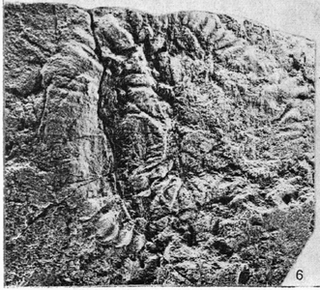
Veprina is a rare Ediacaran coelenterate cnidarian found on the Zimny coast of the White Sea, Russia and was first described by Mikhail Fedonkin in 1980.
Studenicia is a genus of Ediacaran fauna which is approximately 635-545 million years old. All Ediacaran fauna are considered to be invertebrate Metazoans or multicellular organisms with no backbone.
Palaeoplatoda is a genus from the Ediacaran biota. It is a soft-bodied organism with a segmented body that resembles Dickinsonia, another Ediacaran organism.

Ventogyrus is an Ediacaran fossil found in the White Sea-Arkhangelsk region of Russia. It was first discovered in the Teska member of the Ust'-Pinega formation, in a thick lens of sandstone, originally sand dumped by storm waves that cut a deep channel through the shallow sea bottom where the organisms lived. Many individuals were preserved on top of each other, often torn or in distorted positions. As a result, it was originally thought to have had a "boat shaped" form and to have lived anchored in the sea floor. However, a nearby site discovered later by Mikhail Fedonkin yielded separate specimens which were beautifully preserved in an upright position and showed the internal anatomy.
Podolimirus is an extinct monotypic genus of unclassified proarticulates. It presents a single species, Podolimirus mirus. It was found in strata of the late Ediacaran, at the beginning of the Cambrian. It is one of the last proarticulates. The first fossils of this genus and species were found in the Ukraine along the Dneister River close by to the deposits in the Vendian Sequence in 1983.
Atakia is a genus of animals that were members of the Ediacaran fauna, which existed from 635 to 541 million years ago. Discovered in Ukraine in 1979 by Palij, the genus Atakia are soft-bodied Metazoan cast in Vendian sediments found on the Eastern European Platform formations. Oftentimes the genus Atakia is used as a comparison to other genera, because very little information is known about this genus. There is a discontinuity in identification because the genus Fustiglyphus Vialov is debated to be the same as Atakia but found in different regions.
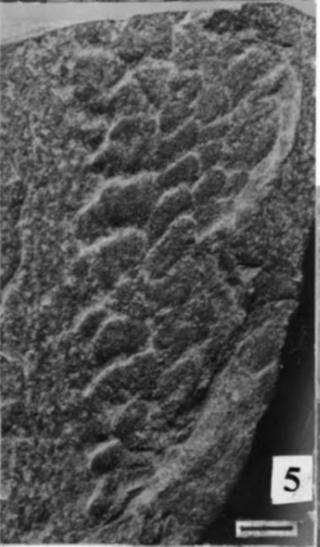
Zolotytsia is an extinct genus of fossil animals from the late Ediacaran period (Vendian) which contains only one known species, Z. biserialis. Specimens of this species have been found in Russia, Ukraine and India.












